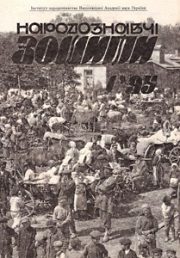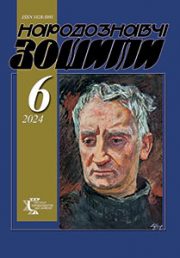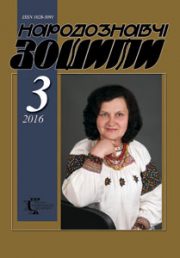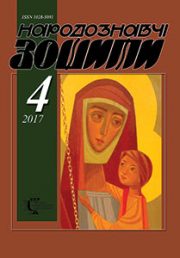The Ethnology Notebooks. 2020. № 2 (152), 395—409
UDK 391.4-055.2:930.2]”16/17″(477)
DOI https://doi.org/10.15407/nz2020.02.395
NAMES OF THIGHS CLOTHES BY WRITTEN SOURCES OF THE XVI—XVIII CENTURIES
KOSMINA Oksana
ORCID ID: https://orcid.org/0000-0002-8382-7438
Candidate of historical sciences,
Doctor of Philosophy, Researcher fellow of department
of Historical Ethnology of the Institute of Ethnology
The National Academy of Sciences of Ukraine,
15, Svobody Avenue, 79000, Lviv, Ukraine
Contacts: e-mail: kosminaoksana@gmail.com
Abstract. On the basis of written sources of the XVI—XVIII centuries, the article describes the terms denoting different types of female and male thigh clothing.
The relevance of the article is due to the writing of a terminology dictionary of clothing terms, which are recorded in written sources from X to XVIII century. To date, the publication of such a dictionary is an important source of research for many studies in the field of historical and art studies. It is also relevant enough for the now popular reconstruction movement, for the work of artists in the preparation of filming historical films, the creation of images of theatrical theatrical art. Knowledge about certain items of clothing will help to eliminate disputes about certain items and time of their appearance in the clothing culture of Ukrainians.
The purpose of the publication. On the basis of written references in sources from the XVI to XVIII century to give an idea of the change of some items of clothing and the constancy of others. Which in turn gives us the opportunity to reasonably speak about the change of fashion, about inethnic borrowings, about the sustainability of traditions. The first mentions in written sources tell us about the existence of a certain element of clothing, and its etymology makes it possible to trace the ways in which the types of clothing indicated by them have got into the material culture of Ukrainians. From the descriptions of certain items, we will also learn about the fabrics from which the garment was made, its cut and decoration, color. Mentions of one thigh outfit together with other types of shoulder wear give us an idea of the ensemble of the suit as a whole. Some of the items in the thigh wear radically change the preferences of a particular community, and from the status of exotic inoethnic borrowings become a national symbol or ethnic marker.
The result of such sources of research was a list of such terms of the thigh clothing as: zapaska, plachta, apron, skirt, sajan, andarak, chusty in women’s clothing and portky, ubranie, pants, charovary, pludry in men’s clothing.
Keywords: terminology, clothing, fabric, cut.
Received 16.04.2020
REFERENCES
Voitiv, H.V. (1955). Names of clothes in monuments of the Ukrainian language of XIV—XVIII centuries. Thesis for a Candidate Degree in Philology. Lviv [in Ukrainian].
(1986). Lokhvytsia Town Hall Book of the Second Half of the 17th Century (Collection of Actual Documents. A series of Monuments of the Ukrainian Language. Series of Acts and Certificates. Kyiv: Naukova dumka [in Ukrainian].
(1976). The business and vernacular language of the eighteenth century (materials of hundreds of offices and town hall of the Left Bank of Ukraine). (Series «Monuments of the Ukrainian language of the eighteenth century». Series of Actual Documents and Certificates). Kyiv: Naukova dumka [in Ukrainian].
(1876). Archive of Southwestern Russia (Vol. 3, part 3). Kyiv [in Russian].
Miller, D.P. (1902). Archives of the Kharkov province. Bogodukhov district. G. Bogodukhov, family papers S.D. Kondratiev. Collection of Kharkov historical-philological society (Vol. 13, pp. 354—372). Kharkov [in Russian].
(1882, november). Galagan’s family archive. Kyevskaia staryna, 11 (Vol. 7, pp. 452—469 [in Russian].
(1970). Haydamak movement in Ukraine in the XVIII century. Collection of documents. Kyiv: Naukova dumka [in Ukrainian].
(1884). Sulimovsky archive. Family papers Sulim, Skorup and Wojciechowicz. XVII—XVIII centuries. Kyiv [in Russian].
V., N.K. (1905, july). Dress and linen of Little Russian lady of the 18th century. Kyevskaia staryna, 7 (Vol. 90, pp. 43—44). Documents, news and notes [in Russian].
(1898). Liubech archive of Count Miloradovich (Vol. 1). Kyiv [in Russian].
(2002). Fashion & Style. The modern encyclopedia. Moscou: Avanta + [in Russian].
Fasmer, M. (1987). Etymological Dictionary of the Russian Language (Vol. 4). Moscow: Progress [in Russian].
(2014). The Ukrainian Everyday of the Early Modern Age: A Collection of Documents (Issue 1): Volyn, 16th c. Kyiv: Phenix [in Ukrainian].
(1891). Acts issued by the Vilnius Archeographic Commission. Land Acts. Vilna [in Russian].
(1863). Archive of Southwestern Russia (Vol. 1, part 3). Kyiv [in Russian].
(1849). The life of Prince Andrei Mikhailovich Kurbsky in Lithuania and Volhynia. Acts issued by the Provisional Commission for the analysis of ancient acts, the highest established by the Kyiv Military, Podolsky and Volyn Governor-General (Vol. II). Kyiv [in Russian].
(1904). Archive of Southwestern Russia (Vol. 11, part 1). Kyiv [in Russian].
(1876). Archive of Southwestern Russia (Vol. 1, part 6). Kyiv [in Russian].
Demchenko, L. (2004). Property orders of Volyn nobles on materials of testaments and registers of hereditary property of XVI century. Archives of Ukraine, 1—2, 112—147 [in Ukrainian].
(1862). The book of the belongings of the former Chernigov colonel Pavel Polubotkov and his children, Andrei and Yakov Polubotkov, compiled by decree of 1724 by Major Mikhail Raevsky and the Life Guard sergeant Lvov. Readings in the imperial society of Russian history and antiquities at Moscow University (Book 3, part V, pp. 1—90). Moscow [in Russian].
Matejko, K. (1996). Ukrainian folk clothing. Ethnographic Dictionary. Kyiv: Naukova dumka [in Ukrainian].
(1911). Archive of Southwestern Russia (Vol. 6. part 8). Kyiv [in Russian].
(1887, october). Domestic Little Russian situation in documents XVII—XVII Art. Kyevskaia staryna, 10 (Vol. 19, pp. 336—356) [in Russian].
(1908). Storozhenkos: Family Archive (Vol. VI). Kyiv [in Russian].
(1853). Description of estates owned by Hetman Daniel the Apostle. Materials for domestic history (Vol. І). Kyiv [in Russian].
Polonskaya-Vasylenko, N. (1932). Property of Zaporizhzhia Elder as a Source for Socio-Economic Study of Zaporozhye History. Essays on the socio-economic history of Ukraine (Vol. I, pp. 43—206). Kyiv [in Ukrainian].
(1883). Archive of Southwestern Russia (Vol. 6, part 1). Kyiv [in Russian].
(1902). Collection of Kharkov historical-philological society (Vol. 13). Kharkov [in Russian].
(1908). The decision in the case of theft of plakht in v. Savantsakh at Andrei Sanenok. 26 january 1703. Storozhenkos: Family archive (Vol. VI, pp. 211—212). Kyiv [in Russian].
(1901, september). The list of the dowry received by the daughter of the Ivanitsky centurion Pavel Minitsky, Melania, when he married in 1748, was married. Canz. Petra Storozhenka. Kyevskaia staryna, 9 (Vol. 73, pp. 146—147). Documents and notes [in Russian].
(1914). Archive of Southwestern Russia (Vol. 4, part 3). Kyiv [in Russian].
Pavlenko, S.O. (Ed.). (2007). Hetman Ivan Mazepa’s Day in Documents. Kyiv: Kyiv-Mohyla Academy Publishing House [in Ukrainian].
Turnau, I. (1999). Dictionary of clothing: textiles, non-stitching wurks, skins, weapons and jewels, and colors known in Poland from the Middle Ages to the beginning of the 19th century. Warsaw: Semper [in Polish].
Storozhenko, A. (1892, february). On the history of Kyiv in the XV—XVI centuries. Kyevskaia staryna, 2 (Vol. 36, pp. 339—347) [in Russian].
Bershadsky, S.A. (1882). Russian-Jewish Archive Documents and materials for the history of Jews in Russia (Vol. II). Documents and registers for the history of Lithuanian Jews (1550—1569). St. Petersburg [in Russian].
Bilous, N. (2011). Kyivans’ Testaments in the middle of the XVI — the first half of the XVII century. Kyiv: Prostir [in Ukrainian].
(1909). Archive of Southwestern Russia (Vol. 3, part 8). Kyiv [in Russian].
(1884). Inventory of movable property owned by Little Russian hetman Ivan Samoilovich and his sons, Gregory and Jacob. Russian Historical Library, published by the Archaeographic Commission (Vol. VIII, stlb. 949—1204). St. Petersburg [in Russian].
(1982). Etymological dictionary of the Ukrainian language (Vol. 1). Kyiv: Naukova dumka [in Ukrainian].
Sreznevsky, I.I. (1912). Materials for the dictionary of the Old Russian language (Vol. 3, 1684 stlb.). St. Petersburg [in Russian].
(1859). Archive of Southwestern Russia (Vol. 1, part 1). Kyiv [in Russian].
(1981). Business language of Volyn and Dnieper region of the XVII century. Monuments of the Ukrainian language of the 17th c. A series of documents and certificates. (Collection of Actual Documents). Kyiv: Naukova dumka [in Ukrainian].
(2005). Autograph of Ukrainian history: IX—XXI centuries. Materials to the Catalog of the Exhibition of Documents of the National Archival Fund of Ukraine. Archives of Ukraine, 5—6 (258), 107—455 [in Ukrainian].
Fasmer, M. (1987). Etymological Dictionary of the Russian Language (Vol. 3). Moscow: Progress [in Russian].
(1965). Act Book of Zhytomyr City Government of the End of the 16th Century (1582—1588). Kyiv: Naukova dumka [in Ukrainian].
(2002). Act Book of the Zhytomyr City Government in 1611 (Series «Monuments of the Ukrainian Language». Series of Act Documents and Certificates). Zhytomyr: Polissya [in Ukrainian].
(1990). Trade in Ukraine in the XIVth — the middle of the seventeenth century. Volyn and Dnieper. Kyiv: Naukova dumka [in Ukrainian].
(2010). Property registers of Jan Frankenstein in 1597 and 1602 (Teslenko I. Traces of Frankenstein in Volhynia). Notes of the T. Shevchenko Scientific Society (Vol. CCLX, bk. 2). Proceedings of the Commission of Special (Auxiliary) Historical Disciplines (Pp. 274—296). Lviv [in Ukrainian].
Golovatsky, Ya.F. (1877). About folk clothes and decoration of Rusyns, or Russians, in Galicia and Northeast Hungary. St. Petersburg [in Russian].
Galenko, O. (2016). Trophies of the Polovtsian leader of the Chungul mound: overdrive, ritual functions and symbolism. Archeology, 4, 42—72 [in Ukrainian].
Shapiro, D.Ya. (2007). Iranian Slavic Studies. Notes on Iranian, Slavic, Eastern European («Rus’»), German, Turkic and Khazar Studies. Ruthenica (Vol. VI, pp. 7—36). Kyiv [in Ukrainian].
(2000). Archive of the New Zaporozhye Sich Kosh: The case of documents. 1734—1775 (Vol. 2). Kyiv: Naukova dumka [in Ukrainian].
Markovich, Y. (1859). Day notes of the Little Russian subcarbia of General Yakov Markovich (Part 2). Moscow [in Russian].
Ogloblin, N. (1889). The rich Kyiv citizen of the end of the XVII century. Kyevskaia staryna, 5—6 (Vol. 5, pp. 578—585) [in Russian].
(2003). Archive of the New Zaporozhye Sich Kosh: The case of documents. 1734—1775 (Vol. 3). Kyiv: Naukova dumka [in Ukrainian].
(1998). Archive of the New Zaporozhye Sich Kosh: The case of documents. 1734—1775 (Vol. 1). Kyiv: Naukova dumka [in Ukrainian].
Lazarevsky. Ol. (Ed.). (1886, september). Diary of General Coronet Nikolai Hanenok (1727—1753). Kyevskaia staryna, 9 (Vol. 16, pp. 191—194) [in Russian].
Baranovich, A.I. (1955). Magnate economy in the south of Volhynia in the XVIII century. Moscow: Publisher of the USSR Academy of Sciences [in Russian].
(1890). Acts issued by the Vilnius Archeographic Commission. Land Acts (Vol. XVII). Vilna [in Russian].
Velichko, S.V., & Shevchuk, V.O. (Ed.). (1991). Chronicle (Vol. 2). Kyiv: Dnipro [in Ukrainian].
Nikolaeva, T. (1996). History of Ukrainian costume. Kyiv: Lybid [in Ukrainian].
Bilan, M.S., & Stelmashchuk, H.H. (2000). The Ukrainian costume. Lviv: Apriori [in Ukrainian].
Yavornitsky, D.I. (1990). History of Zaporozhye Cossacks (Vol. 1). Lviv: World [in Ukrainian].
(1990). Beauplan Guillaume Levasser de. Description of Ukraine, several provinces of the Kingdom of Poland extending from the borders of Muscovy to the borders of Transylvania, together with their customs, way of life and waging wars. Kyiv: Naukova dumka [in Ukrainian].
Description of Ukranie, which are several provinces of the Kingdom of Poland. Contained from the confines of Muscovy, insques on the borders of Transylvania. Together their manners, ways of life, and to make the War. By the Sieur de Beauplan. In Rouen, Chez Jacques Cailloue, 1660 [in French].
Shamenkov, S. (2015). Belt of clothing in the wardrobe of the population of Ukrainian lands and in the costume of the Cossacks at the end of the XVI — first half of the XVII century. Community Blog and Cossack Reconstruction (17th c.). Retrieved from: http:xviic.blogspot.com/2015/07/xvi-xvii.html [in Ukrainian].
(1901). Inventory of household items of Bunchukovy comrade Grigory Fridrikevich. Kyevskaia staryna, 2 (Vol. 72, pp. 82—83). Documents, news and notes [in Russian].
Masliychuk, V. (2002). On the history of women’s clothing in the Slobozhanshchina region (according to the criminal case materials of 1792). Collection of the Kharkov Historical and Philological Society. New series (Vol. 9, pp. 232—237). Kharkiv [in Ukrainian].
(1991). Descriptions of Kharkov governorate of the late eighteenth century: Descriptive and statistical sources. Kyiv: Naukova dumka [in Ukrainian].
Teslenko, I. (2010). Traces of Frankenstein in Volhynia. Notes of T. Shevchenko Scientific Society (Vol. CCLX, bk. 2. pp. 274—296). Proceedings of the Commission of Special (Auxiliary) Historical Disciplines. Lviv [in Ukrainian].
(1865). Acts relating to the history of southern and western Russia, collected and published by the Archeographic Commission (Vol. 2). St. Petersburg [in Russian].
Efimenko, A. (1887). Antique clothing and household appliances Sloboda. Kharkov collection (Issue 1, pp. 171—181) [in Russian].
Shafonsky, A. (1851). Chernigov governorate topographic description with a brief geographical and historical description of Lesser Russia … in Chernigov 1786. Kyiv [in Russian].







